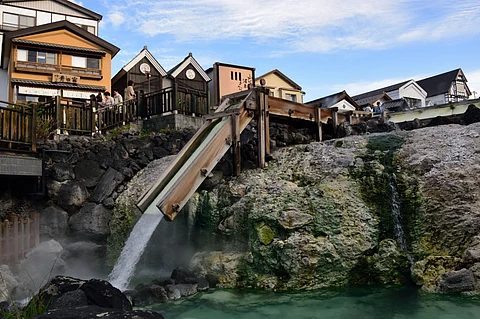
- Destinations
- Experiences
- Stay
- What's new
- Celebrating People
- Responsible Tourism
- CampaignsCampaigns
- SubscribeSubscribe
- Buy Now

In Japan, an influx of unprecedented tourism is posing a serious threat to the country's famous onsens, or hot springs. Although onsens have long attracted both domestic and foreign tourists equally, the sharp rise in tourism has led to severe water shortages in a number of well-renowned onsen locales. Such a natural crisis has caused local authorities to implement measures to curb the damage apart from raising questions about the sustainability of these natural thermal spas.
In 2024, Japan witnessed a surge in tourist arrivals, with nearly 33.4 million visitors recorded between January and November. Among them, approximately 247,500 were American tourists who visited in November alone. This influx has significantly benefited Japan’s economy but has also led to severe overcrowding at many popular destinations. Reports suggest that nearly 30 percent of tourists experienced overcrowding issues, while 28 percent indulged in hot spring experiences, with 48 percent expressing interest in visiting an onsen in the future.
Water availability in a number of areas has been directly influenced by the rise in demand for hot spring experiences. Saga Prefecture's famous onsen town of Ureshino has been among the hardest hit. The average water level at Ureshino's hot spring sources fell sharply from 50 metres (160 feet) four years prior to a record low of 39.6 metres (130 feet) in 2024. Local authorities have asked hotels and ryokans to limit the usage of private in-room baths, particularly late at night, in order to save water.
The charming hot spring village of Ginzan Onsen in Yamagata Prefecture is likewise facing difficulties brought on by excessive tourists. Famous for its picturesque scenery and old inns, the town has seen a surge in tourists who come only to take pictures, which has caused traffic jams and sporadic arguments between guests. Authorities have responded by enacting ticketed evening trips and restricting day-trippers' access during rush seasons.
The Japanese government and local municipalities have been working on methods to protect onsen resources in recognition of the escalating situation. Raising the regular bathing tax at well-known hot spring locales is one of the suggested policies. The fee, which is now fixed at about USD 0.98 per day, is anticipated to increase to about USD 2 in some places. Furthermore, a number of Hokkaido towns have already imposed accommodation taxes, and other areas are thinking about implementing such measures to control the number of visitors and maintain sustainability.
Additionally, local governments are promoting off-peak tourism to alleviate the strain on hot spring resources. The goal is to more evenly disperse visitors and cut down on excessive water use by encouraging visits during off-peak periods of the year. To meet future tourism demands while protecting these natural resources, infrastructure expenditures are also being given priority, such as creating alternate water sources and improving onsen facilities.
Onsens play a crucial role in both the tourism sector and Japan's cultural legacy. Their viability is seriously threatened, nevertheless, by the mounting pressure brought on by an increase in tourists. Local governments, federal legislators, and business stakeholders must work together to address these issues. Japan hopes to maintain its beloved hot spring customs while meeting the increasing demand for these healing pools around the world by strengthening infrastructure, encouraging responsible travel, and putting sustainable tourism policies into place.
(With inputs from various sources.)
